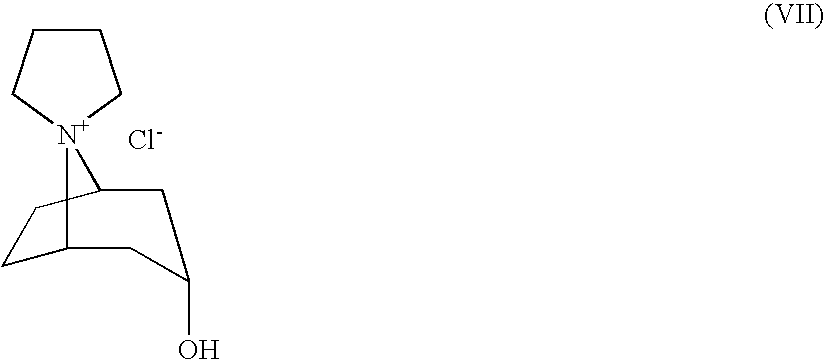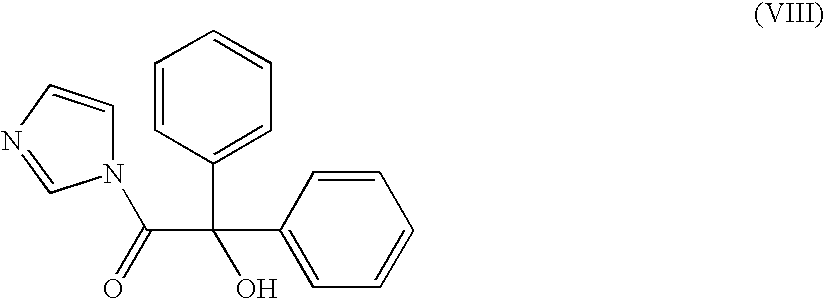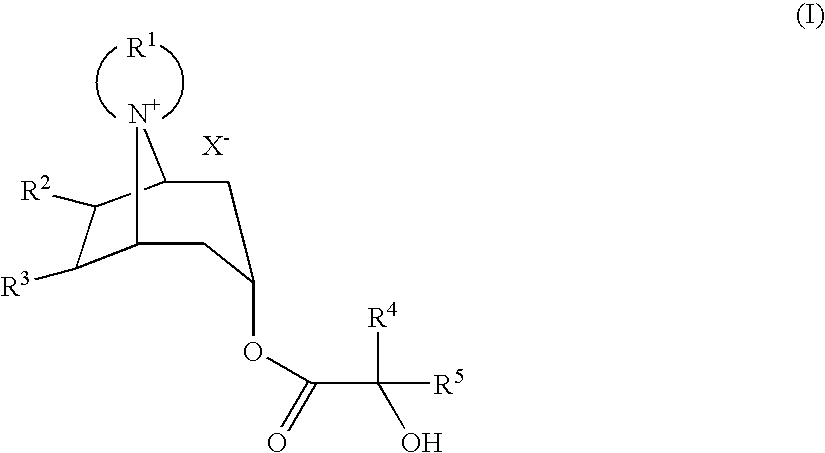Method For Producing Azoniaspironortropine Esters And Nortropan-3-One Compounds
a technology of azoniaspironortropine and esters, which is applied in the field of single-stage method for producing azoniaspironortropine esters and nortropan3one compounds, and achieves the effect of being ready to solubl
- Summary
- Abstract
- Description
- Claims
- Application Information
AI Technical Summary
Benefits of technology
Problems solved by technology
Method used
Image
Examples
example 1
[0090]1,4-Dichlorobutane (52.4 g, 0.4 mol) and DMF (100 ml) were initially introduced in a reaction vessel at 80° C. and a solution of endo-nortropine (25.5 g, 0.2 mol), and DBU (88.8 g, 0.3 mol) in N,N-dimethylformamide (DMF, 150 ml) was added over the course of 1 h and the reaction mixture was afterstirred for a further 1 h at 80° C.
[0091]1,1′-Carbonyldiimidazole (48.6 g) and DMF (100 ml) were initially introduced in a second reaction vessel and a solution of benzylic acid (69.2 g, 0.3 mol) in DMF (150 ml) was added over the course of 30 min at a temperature of 20° C. The reaction mixture was stirred for 1 h at 20° C.
[0092]At 80° C., N,N-dimethylaminopyridine (2.5 g, 0.02 mol) and the suspension of benzylic acid imidazolide prepared as described above were added to the reaction mixture of 1,4-dichlorobutane and endo-nortropine over the course of 5 min and the resulting mixture was further stirred for 1 h at 80° C.
[0093]The reaction mixture was cooled to 0° C., filtered and the yel...
example 2
[0095]1,4-Dichlorobutane (5.24 g, 40 mmol) and DMF (10 ml) were heated to 80° C. under nitrogen and endo-nortropine (2.55 g, 20 mmol) and DBU (4.57 g, 30 mmol) dissolved in DMF (15 ml) were added dropwise. After one hour, the mixture was cooled to 20° C., benzylic acid (6.92 g, 30 mmol) and CDI (4.86 g, 30 mmol) were added, the mixture was stirred for one hour, DMAP (250 mg, 2 mmol) was added and the mixture was heated at 80° C. for one hour. Upon cooling to 0° C., the product of value crystallized out and was filtered off, washed with DMF (2×5 ml) and acetone (2×10 ml) and dried in a stream of nitrogen. Trospium chloride, crude (7.1 g, 82.2% strength, 68%) was obtained in the form of a virtually colorless, crystalline solid.
example 3
[0096]Preparation of solution 1: 365.3 g of 1,3-acetone-dicarboxylic acid were dissolved in 1050 g of 5 molar sodium hydroxide solution while cooling in an ice bath.
[0097]Preparation of solution 2: 626.5 g of 32% strength hydrochloric acid and 187.5 g of benzylamine were dissolved in 1150 ml of completely demineralized water. 363.8 g of 2,5-dimethoxytetrahydrofuran were added to this solution. This mixture was stirred at room temperature for half an hour.
[0098]Solution 2 and solution 1 were added in parallel over the course of three hours to a stirred reactor with a volume of 4 l. Here, solution 2 was introduced into the reactor continuously and solution 2 was metered in such that the pH of the resulting reaction mixture was 3.5+ / −0.1 over the entire duration of the addition. After an addition time of three hours, the remainder of solution 1 was added over the course of 10 minutes. The resulting reaction suspension was then stirred for two hours at room temperature.
[0099]During this...
PUM
 Login to View More
Login to View More Abstract
Description
Claims
Application Information
 Login to View More
Login to View More - R&D
- Intellectual Property
- Life Sciences
- Materials
- Tech Scout
- Unparalleled Data Quality
- Higher Quality Content
- 60% Fewer Hallucinations
Browse by: Latest US Patents, China's latest patents, Technical Efficacy Thesaurus, Application Domain, Technology Topic, Popular Technical Reports.
© 2025 PatSnap. All rights reserved.Legal|Privacy policy|Modern Slavery Act Transparency Statement|Sitemap|About US| Contact US: help@patsnap.com



